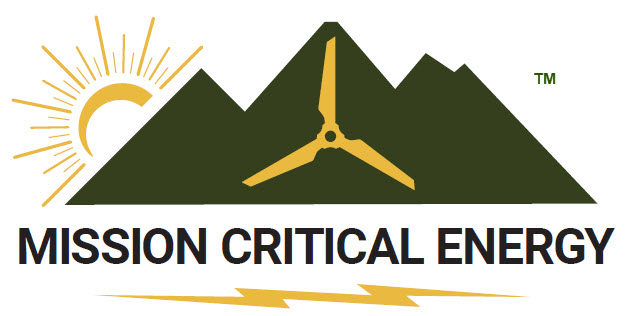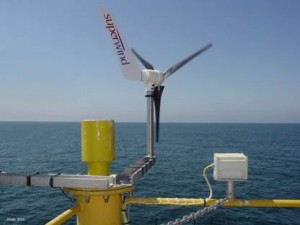The superwind 350 Micro Wind Turbine
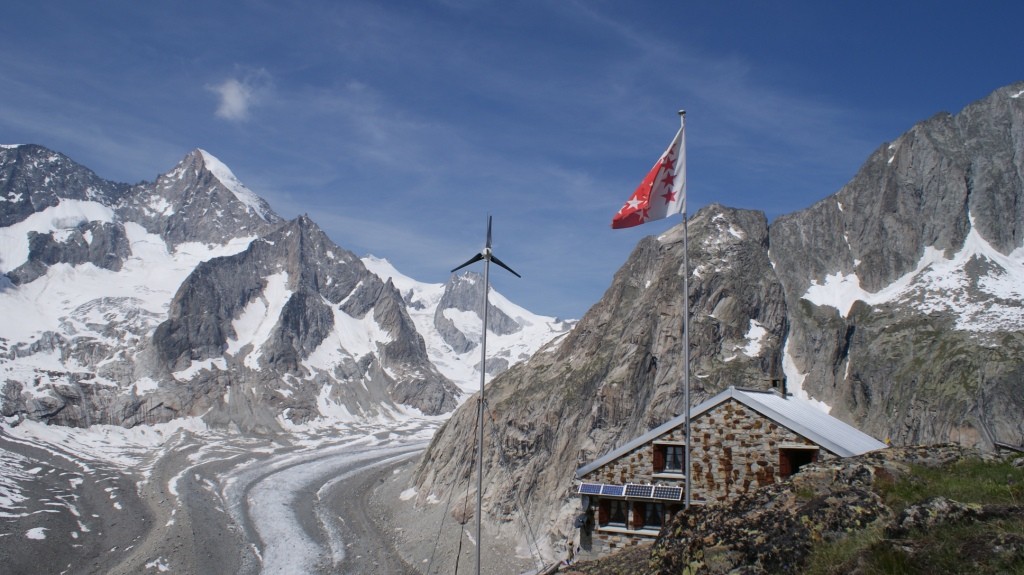
In the Off-Grid Power Generation world, especially when it comes to micro wind turbines, the name superwind is synonymous with survival. Of course the reason most professionals only will use this commercial/professional rated equipment is they likely have had to use something else in the past, and it didn’t work very long. And, for those same professionals, ‘survival” isn’t enough – it has to make reliable power. Superwind does both, but before we explain how, a little history is relevant.
Micro-wind turbines (electric wind generators typically 100 to 2000 watts) have been around for well over 50 years. They were fun for hobby types, useful for sailors on sailboats who knew when to leave them off so they did not self-destruct in high winds, or worse yet blow the battery bank apart from over-speed based overcharging. Oh, and then there was the high speeds, noise and vibration. Two blades, four blades, five blades and even some six bladed rotors stuck on an auto class alternator, all called 'wind tubrines' and none of them balanced... this means noise. The more wind power ,the more noise, until the turbine finally blows apart and only then gets quiet. It is no wonder why so many off-grid professionals as well as their customers who paid for these types of hobby wind turbines have a very bad feeling about “wind”. One really could not blame them.
This all changed in 2002, when Martin van Egeren and Klaus Krieger founded superwind – and brought to the industry some much needed common sense and some fascinating German Engineering. By working directly in the field with off-grid end users, superwind could focus on the real world need. Mr. Krieger will be the first to state the obvious quickly: Noise is from vibration, vibration is from a lack of balance, and a lack of balance is from poor quality components, poor workmanship, or both. This brings us back to our products.
Superwind Turbines are made of the highest quality materials: salt water resistant aluminum alloy, and stainless steel. They are built to exacting standards and must overcome scores of pass/fail tooling points and multiple inspection steps – even before being individually quality control tested when fully constructed.
But balance is only part of the success equation. One of the most well-known turbine terminating factors is ‘over-speed’. When a low quality turbine is launched over-speed by high winds, it rapidly starts shaking its mast or rigging, it heats and wears out its bearings, it overpowers its stator and is forced to either absorb the energy as heat, or discharge high amperage into the charge controllers and/or overcharge fragile but expensive battery banks. Basically in wind turbine terms “over-speed” means repeated steps of escalating damage until the ultimate failure of some, or all, of the equipment is reached. But not with a Superwind Turbine:
Superwind Turbines avoid over-speed operation through their patented and real world proven auto-feathering blade system. Again, this is not new to us; we have been proving the worth of this advanced robust technology for over a decade and counting. How it works is one of the best questions our customers ask: As the lateral force of the wind moves the turbine into rated power speeds (about 22 knots) the blades automatically and individually change pitch into a passive angle to the wind force, in real time. This means the blades’ ‘feathering action’ occurs in micro-moments and in micrometers of movement, and the blades automatically recover to their normal position as the wind force lessens. The blades can actually pitch up to 40 degrees! The technology that allows this simple operation is quite remarkable, yet is robust enough to operate for a decade or more – even in Arctic and Desert conditions. Click here to read a great recommendation from the arctic
Yet, Ultra Quiet operation, an Auto-Feathering Over-speed avoidance system, the highest quality saltwater materials and proven power production in modest to high winds, is still not enough to satisfy the engineers at superwind. With over twenty years of wind turbine experience the superwind team knew that our customers needed more. We knew that a turbine does not work by itself – it is part of a larger system, and successful integration means more than selling a wind turbine and walking away. So superwind set about to build a better charging strategy, and in doing so changed the industry.
Twelve years ago we were the first and only to incorporate a dump load resistor system into our charge controller set. This allows the turbine to be left on, allowing unattended operations (making power) 24/7 when ample wind is present. By charging the batteries within to the manufacturers specifications and dumping the power only after the batteries are fully charged, we have created a charging system that is truly autonomous, reliable and highly efficient. Today our system is so advanced that we are the only micro-wind turbine ‘Valance Verified’- meaning we are qualified to charge Lithium Iron Magnesium Phosphate (LiFeMgPO4) batteries and energy storage systems.
 Another question we are frequently asked is whether we can work with other charge sources? YES! The superwind was designed to work alongside Solar Panels, Fuel cells, etc., and we are often partnered with diesel generator systems as we are great in delivering fuel conservation advantages in windy areas.
Another question we are frequently asked is whether we can work with other charge sources? YES! The superwind was designed to work alongside Solar Panels, Fuel cells, etc., and we are often partnered with diesel generator systems as we are great in delivering fuel conservation advantages in windy areas.
Because our valued commercial clients often use superwind turbines proximate to SatCom stations, Communication antennas, sensor nodes and even weather and seismic equipment (on tsunami detectors at sea for instance), we have taken the additional steps to remove electronic noise and magnetic vibration by utilizing a brush-less offset AC stator to produce power, then added RF Gain dampeners to the DC Rectifier to assure no interference from turbine power generation and transmission. All superwind 350 turbines are DC output and available in 12v, 24v (military 28.8v) and 48v. It is also worth mentioning that at no time do the special features of a superwind turbine interfere with making power. Click here to see our SW350 power curve
 If you think about it, our reputation is based on the off-grid professional hopping aboard a $4,000.00 roundtrip helicopter ride to a communication tower atop a mountain to install a micro-wind turbine to help power lifesaving equipment. You might ask if that is the time to save money by using a cheap hobby wind turbine? For our experienced customers, the answer is: no way! And that is the reason that every superwind is tested to the same high standards.
If you think about it, our reputation is based on the off-grid professional hopping aboard a $4,000.00 roundtrip helicopter ride to a communication tower atop a mountain to install a micro-wind turbine to help power lifesaving equipment. You might ask if that is the time to save money by using a cheap hobby wind turbine? For our experienced customers, the answer is: no way! And that is the reason that every superwind is tested to the same high standards.
There are many mast options to integrate a superwind. The good news is that often a superwind can be installed on locally sourced mast structures, even those masts once occupied by failed turbines! Once properly installed, the superwind can work for decades where the other turbines failed in months or weeks.
We will be the first to remind you that wind turbines work where there are ample wind resources, and many potential customers are surprised when, by experience, we suggest a superwind might not work for a given project. That is another superwind difference – you are working with trained professionals, not some E.Com/Store saying anything to sell. So to help you understand if your project and site is appropriate for using a superwind turbine, we welcome you to contact our staff or any of our authorized agents, anytime.
Superwind 350 Turbine Versions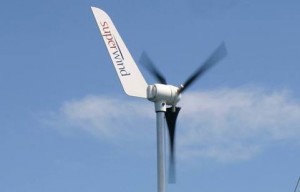
SW350
The SW350 Is available in DC output; 12V, 24V (Military 28.8V) or 48V. SW350 turbines are available only as kits; with charge controller, safety switch and dump load resistor included. A Delrin mast integration bushing comes standard with these turbines, however a stainless steel version is available for high tower and high wind applications.
SW350-SV
The SW350-SV Sailing Vessel version, shares all the features described above, however this series includes a white Delrin mast bushing with dampener rings. It is available in DC output; 12V, 24V (Military 28.8V) or 48V,
and is available only as a kit; with charge controller, safety switch and dump load resistor included.
All superwind 350 turbines share the same installation manual. click here to read the SW350 instructions.
superwind 350 technical data
- rated power 350 Watts
- rated wind speed 12.5 m/s
- cut in wind speed 3.5 m/s
- cut off wind speed none
- rotor diameter 1.22 m
- number of blades 3
- blade material CFRP (Carbon Fibre Base)
- rotor speed 500-1300 rpm
- generator permanent magnet, 3-phase w/ Neodymium magnets
- voltage output 12VDC, 24 VDC or 48 VDC
- connection charge controller
- speed regulation passive pitch control
- power regulation passive pitch control
- main brake electro dynamic - generator short-circuit
- weight 11.5 kg
- rotor thrust (operation) 64 N
Color Choices:

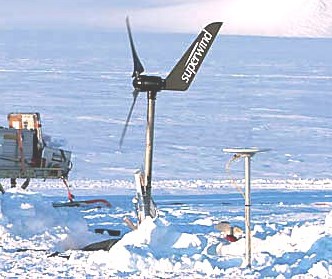
All superwind 350 series units are white in color with black carbon fiber blades; however we offer 24v & 48v superwind 350 units in Black Color for the Military and other customers who have standardized on that color. Black units are available to all customers – however, this color may have to be pre-ordered. There is no extra charge for Black color SW350 Units. The turbines are also available without our logo.
SW350 High Visibility Blades
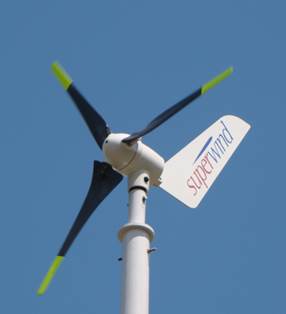
The superwind High Visibility Blade Set is an option that can be added to your original order or purchase later as they will fit any superwind 350 turbine. The special blade set is slightly more expensive that the standard blade set due to secondary balancing and application costs.
This special yellow green color was developed by the French Coast Guard a decade ago, and in 2006 we perfected its application on special order blade sets. This high tech paint proved to not only be easier to see at dusk and dawn (a safety benefit) it also allows birds to safely avoid the turbine while in operation. As you would imagine, sea gulls love light houses – and we provide power by way of our turbines to a majority of the French Coast Gua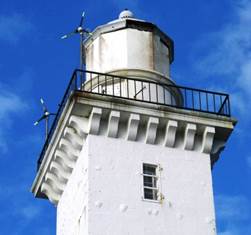 rd’s Light House Facilities. In 2008 we made this product available to all our customers (again after years of real world testing). We are happy to say there has never been a reported strike with these blades in our history. These High Visibility Blade sets are a standard now at most North American wildlife areas and have been used on turbines working on utility towers where Eagles and hawks often visit – again with wonderful result.
rd’s Light House Facilities. In 2008 we made this product available to all our customers (again after years of real world testing). We are happy to say there has never been a reported strike with these blades in our history. These High Visibility Blade sets are a standard now at most North American wildlife areas and have been used on turbines working on utility towers where Eagles and hawks often visit – again with wonderful result.
